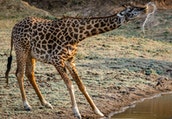- 1. Aardwolf Description: The Aardwolf is a small carnivorous mammal that resembles a hyena but is much smaller in size. It has a unique appearance with a long, slender body, a bushy mane along its neck and back, and vertical stripes on its fur.
- 2. Aardwolf Distribution: Aardwolves are native to eastern and southern Africa. They can be found in countries such as South Africa, Namibia, Botswana, Zimbabwe, Mozambique, and parts of East Africa.
- 3. Aardwolf Habitat: Aardwolves inhabit open grasslands, savannas, and scrublands. They prefer areas with sandy or loamy soils where they can dig their dens.
- 4. Aardwolf Diet: Aardwolves are primarily insectivorous. Their diet mainly consists of termites, particularly harvester termites. They use their long, sticky tongues to lap up termites from their mounds. Occasionally, they also consume other insects, such as beetles and ants.
- 5. Aardwolf Behavior: Aardwolves are nocturnal animals, meaning they are active during the night. They are solitary creatures, although they may be found in pairs or small family groups. They are non-aggressive and tend to avoid confrontations. When threatened, they rely on their camouflage and ability to emit a foul-smelling odor to deter predators.
- 6. Aardwolf Conservation Status: The Aardwolf is classified as a species of "Least Concern" by the International Union for Conservation of Nature (IUCN). Although their populations are generally stable, they can face local threats due to habitat loss, habitat fragmentation, and the use of pesticides that may negatively affect their termite food sources. Conservation Status of Aardwolf
- 7. Aardwolf Reproduction: Females go into estrus only once a year, during which the normally solitary animals come together to mate. Aardwolves develop pair bonds during mating season, though sometimes both males and females will mate with other animals as well. Gestation lasts about 90 days, with litters consisting of one to four cubs. Aardwolf Reproduction
- 8. Aardwolf Unique Adaptations: Aardwolves have specialized teeth and jaws adapted for feeding on termites. They have long, sticky tongues that can extend up to 30 centimeters (12 inches) to reach inside termite mounds. Unlike their hyena relatives, they are not built for hunting large prey but are specialized termite eaters.
- Aardvarks: The aardvark is a unique mammal native to Africa. It is known for its distinctive appearance and specialized feeding habits. Here are some key points about aardvarks: Aardvarks have cultural significance in some African societies. They feature in folklore, myths, and art of certain indigenous communities. In popular culture, aardvarks have been depicted in various forms, including children's books and cartoons (e.g., the character Arthur from the animated series "Arthur" is an aardvark).
Aardwolf in Africa:
The Aardwolf (Proteles cristata) is a fascinating mammal found in Africa. The Aardwolf is a remarkable and lesser-known species of Africa's wildlife. Although not as well-known as some of Africa's iconic mammals, it contributes to the continent's unique biodiversity and plays an important role in its ecosystem. Watch the video to see the aardwolf in the wild
Here are some key facts about the Aardwolf:








 |
|  |
|  |
|  |
| 